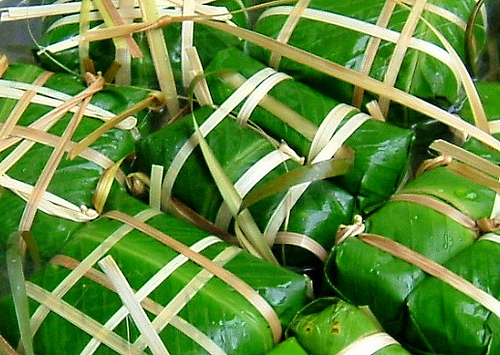Banh Chung: Of Rice Cake and History

Banh Chung (square rice cake) is a traditional Vietnamese rice cake made from glutinous rice, mung bean, pork and other ingredients. With a rich history and delicious taste, it's no wonder it has earned a fixed stature in the tables of Vietnamese traditions such as Tet.
According to Vietnamese history, Banh Chung originated in the Hong Bang Dynasty during the reign of the 6th Hung emperor. When he became too old to rule and needed someone to inherit his throne, he held a cooking contest for his 21 sons, of which the winner will become the next ruler. While most of the princes travelled far and wide to look for a one-of-a-kind food that will win the approval of their father, Lang Lieu, the 18th son, stayed home, not by choice but mainly out of necessity. He was the poorest and loneliest of the lot and couldn't afford to travel or buy exotic foods.
Lang Lieu said to one day dreamed of a fairy who helped him concoct two kinds of cakes “Banh Chung” and “Banh Day.” On the day of the contest, he and his wife presented their cakes to the king. His brothers laughed at his seemingly simple and strange products while theirs were made of the high quality, expensive kind. But to everyone's surprise, their father was greatly impressed with Lang Lieu's cakes and asked how he came up with such delicious dishes. He explained that Banh Day represented the sky, made with glutionous rice and formed into a round shape. Banh Chung on the other hand symbolized the earth and was made by molding a square rice cake stuffed with cooked bean paste and ground meat. Emperor Hung declared Lang Lieu the winner, passed the throne to him, and since then, Banh Chung and Banh Day became traditional foods every Tet.
Through time, different ways of preparing and serving Banh Chung have developed. It can still be served in its traditional recipe and form, or as some may prefer, fried. This is called Banh Chung Ran and best eaten during the cold season. It can also be wrapped to form a cylindrical shape but with the same traditional ingredients, called Banh Tet. A special kind of Banh Tet exclusive in the North is served with mung bean and little or no pork at all. This is called Banh Tay or Banh Chung Dai (Long Banh Chung) which can even be preserved for a longer period of time than the usual.
Banh Chung has also become specialized, becoming region-based, personal-based, and even religion-based to suit all tastes: Banh Chung Gu (Humped Banh Chung) is made specifically by and for the San Diu people; Banh Chung Chay (Vegetarian Banh Chung) is a special kind for the vegetarians and Buddhists; Banh Chung Ngot is sweetend Banh Chung, among others.
In the old days, Banh Chung was one instrument of bonding a family by bringing them together in making and eating the dish. Although such practice is no longer as prevalent before than in recent times, Vietnamese families still keep the tradition of serving Banh Chung during Tet as a symbol of their love and loyalty to their ancestors. In fact, Banh Chung plays such an important role in Vietnamese tradition that a poem was even made about it.









